A well-designed internal communication policy can help you streamline company communications and improve productivity. This guide tells you how.

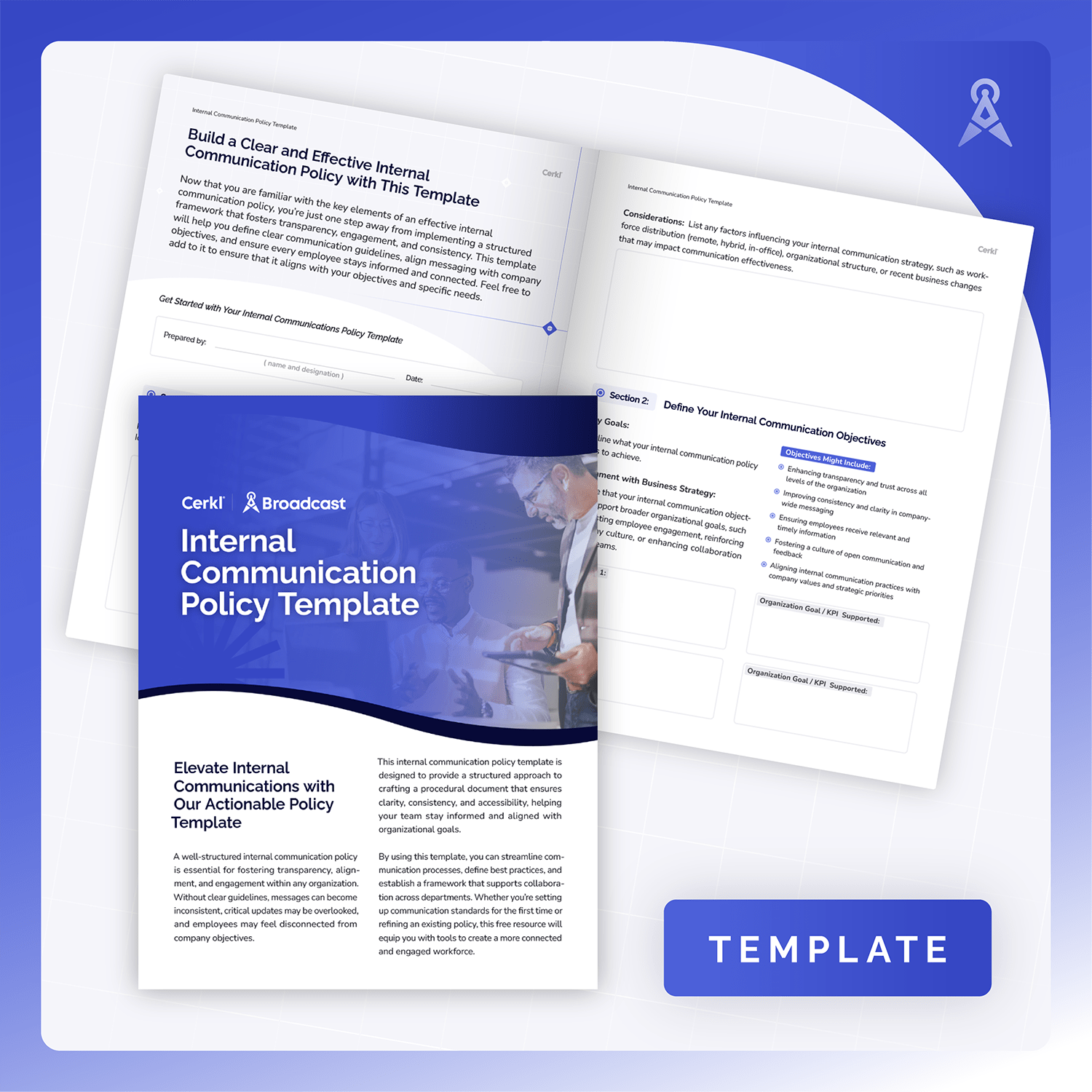
Improve your internal comms policy to maximize its impact and increase engagement. Download our free template now.
Access Now
Does your company have an efficient internal communication policy? If not, it’s time to rethink. Understanding the importance of internal communications, identifying best practices, developing an effective policy, and leveraging the right tools and strategies are vital for establishing a robust, successful internal communication system.
We’re going to explore the expansive field of internal communication policies. We’ll analyze the integral components along with the benefits you can reap when you develop an effective internal communication policy. This guide offers the foundation you need to streamline communications within your organization, driving efficiency, productivity, and overall success.
An internal communication policy is a formally agreed document that defines how information is shared within an organization. It outlines the purpose, scope, acceptable use of company resources, communication channels, frequency, tone, and the responsibilities of employees and communication teams. Primarily, it serves as a guide to appropriate processes and etiquette for internal communications, ensuring clarity, consistency, effectiveness, and compliant communication practices.
A well-developed policy also provides directives on using communication software, handling crises, and maintaining compliance. It should reflect company values, support employee engagement, and align with organizational goals. By providing structure and coherence, it strengthens internal communication and contributes to a more connected and informed company culture.
Gallagher’s Employee Communications Report 2025 features findings and insights from its State of the Sector 2024/25 survey. As with the 2023/24 report, it proves that there is a strong correlation between internal communication, strategic alignment, and culture. And of course, the common factor that connects all of these is the internal communication policy.
In the 2024/25 survey, respondents, 83% of whom represented internal and corporate comms, HR (people and talent), and PR, were asked what the purpose of internal communications was in 2025. The top two answers, assessed by volume and rank, were:
Two others that clearly play key roles were identified as:
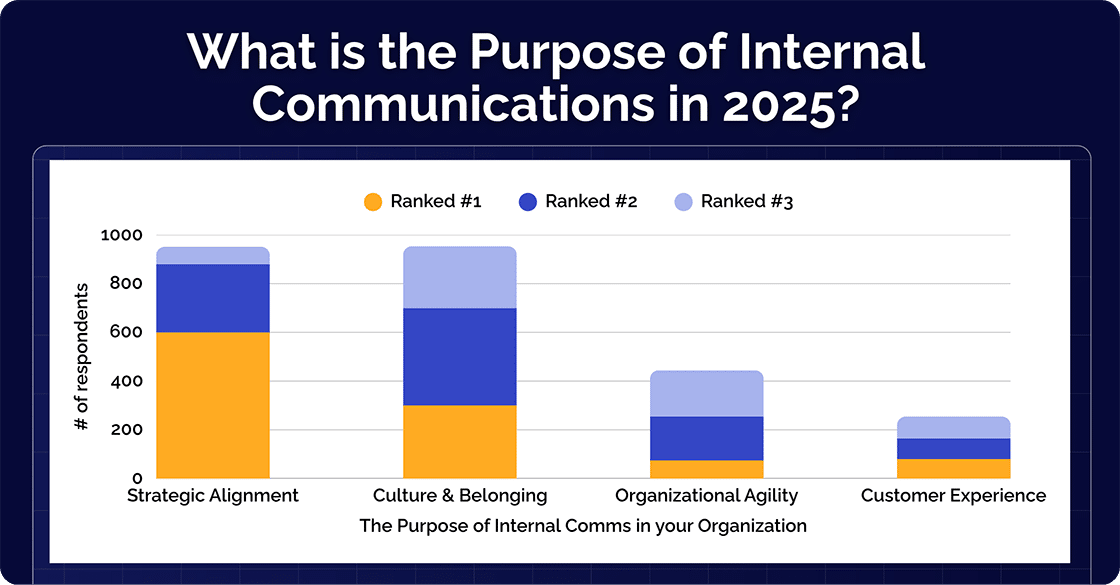
The top four in terms of volume. The differentiated colors indicate rank. So, while slightly more respondents chose Culture and belonging, a lot more ranked Strategic alignment as being more important.
Any effective internal communication policy helps to ensure that all communications within a business are coordinated. While every company’s protocols are uniquely suited to its needs, there are a few components that all effective communication policies typically share.
These include objectives, methods, tools, and responsibilities.
The purpose of any effective internal communication policy is to increase employee engagement, support company culture, and help achieve organizational communication goals. It should clearly state why the policy exists, whether that’s to foster transparency, ensure consistency, improve alignment with company objectives, or all of these elements.
Beyond just setting goals, the policy should also define its scope by specifying which employees, departments, or teams are covered, and what types of information or messages fall under its governance. This helps eliminate ambiguity and ensures that everyone understands their role in maintaining clear and effective communication.
Additionally, the policy should outline the expected frequency of communication — whether it's daily operational updates, weekly team check-ins, or quarterly leadership messages. Establishing consistent timing reinforces habits and sets expectations, helping communication become a reliable part of daily operations rather than an afterthought.
Without clear objectives and structure, a policy risks becoming a static document rather than a living guide that actively shapes and supports internal communication.
An internal communication policy should also clearly define the methods used to share information within the organization. These methods may be formal or informal, verbal or written, and should be chosen based on the message, audience, and urgency. The policy should outline accepted communication channels including email, intranet, newsletters, instant messaging, meetings, presentations, or internal social media platforms.
Each channel plays a unique role in the communication ecosystem. For example, email might be best suited for formal announcements, while messaging apps enable quick, informal exchanges. The policy should help guide when and how to use each channel appropriately.
Additionally, it should address the tone, language, and style suitable for different communication methods. This will ensure that internal messages remain consistent, respectful, and aligned with the company’s culture, regardless of format. This clarity helps employees choose the most effective and appropriate communication tools for any given context.
The policy should identify which internal communication tools the organization will use to support effective and consistent messaging. These may include the company newsletter, intranet, branded internal communication apps, instant messaging platforms, or document management systems. Clearly defining approved tools helps streamline workflows, reduce confusion, and minimize the communication overload that often results from using too many disconnected platforms.
To ensure these tools are being used effectively, the internal communication policy should also address evaluation and analytics. This includes setting clear metrics to measure the impact of communication efforts such as employee engagement scores, open rates on newsletters, or feedback from communication satisfaction surveys. Regularly analyzing these metrics allows the organization to refine its communication strategy, identify gaps, and ensure the tools are helping (not hindering) internal communication goals.
One of the most vital elements of an internal communication policy is defining who is responsible for its implementation, oversight, and day-to-day execution. This includes broad accountability for the communications team, as well as specific responsibilities for department heads, team leads, and even individual employees. Clarifying these roles ensures consistent messaging, proper use of tools, and accountability across the organization.
In addition, the policy should address confidentiality, outlining how sensitive or private information should be handled, stored, and shared. This helps safeguard company data, ensures compliance with privacy regulations, and builds trust among employees. By making confidentiality a shared responsibility, the policy reinforces a culture of integrity and professional communication.
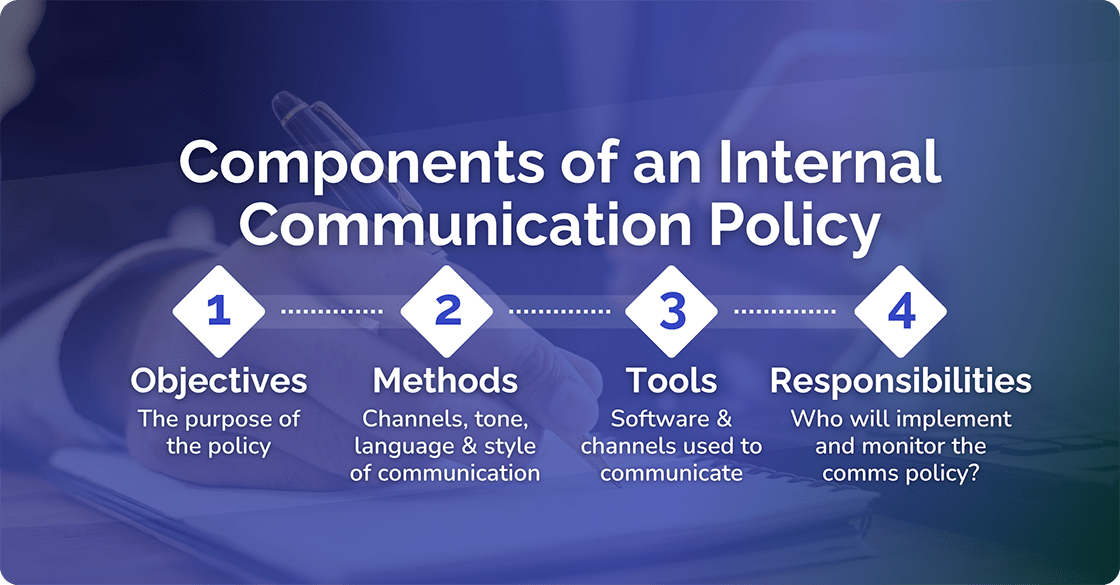
HR research firm, McLean & Company urges businesses to craft an internal communications strategy. They make the point that while internal communications are commonly considered to be crucial, they aren’t always strategic.
Their advice is to craft an effective internal communications strategy that will enable your organization to meet its strategic goals.
“Empowerment starts with the clarity, tools, and capability to communicate effectively and guarantees an exchange downwards and upwards.”
McLean & Company
We get this because we know how important it is to have a good internal communication strategy. But how does this differ from a formal internal communication policy?
Essentially, while an internal communication policy provides guidelines for how communication should be conducted within an organization, an internal communication strategy is a more holistic plan. Simply put, the strategy aims to use communication as a strategic tool to achieve organizational goals. The policy is more focused on establishing rules and standards, while the strategy is focused on the proactive planning and execution of communication initiatives to drive desired outcomes. Nevertheless, both are essential components of a comprehensive internal communication framework within an organization.
This template helps organizations establish clear, consistent internal communication practices that align teams, reduce confusion, and support a more connected workplace culture.
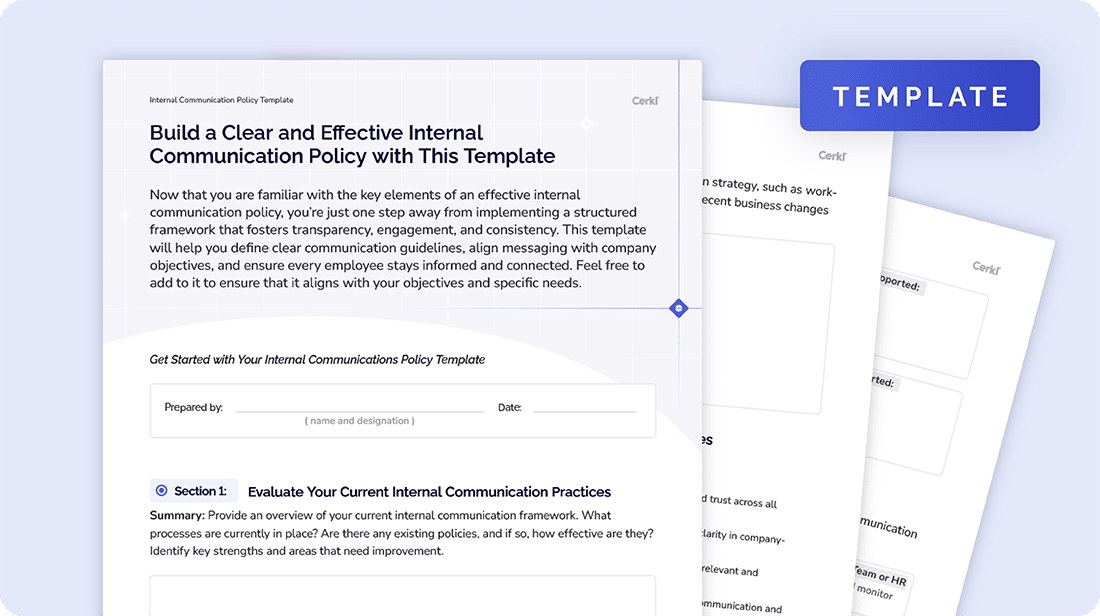
Every business thrives on good internal communications. So, it makes 100% sense to create a clear-cut internal communication policy to ensure clarity and smoothness to maximize the efficiency of company operations. When communications aren’t clear, they often lead to confusion and loss of productivity in the workplace. This also makes internal communication strategies crucial in any organization, regardless of its size or industry.
An internal communication policy becomes the backbone of company operation, guiding both the communications team and the rest of the employees on the right path.
This may seem basic in principle. But it’s essential to recognize that an effective internal communication policy can transform any business operation. It can add value, support company culture, and even increase engagement among team members. It’s not just a document but a powerful tool that can determine the success of your overall internal comms strategy.
Gallagher’s 2025 report highlights that aligning internal communications with business strategy is paramount. Engaging employees in the organization's purpose, strategy, and values emerged as the top priority for internal communication professionals in 2024. Such strategic alignment ensures that internal communications effectively support business growth and employee engagement.
We’ve talked about how important Gallagher found strategic alignment to be from its most recent State of the Sector survey. Strategy (along with vision) also ranks highest on the list of the top 10 topics that businesses communicated most during 2024. Additionally, the survey found that comms strategy and planning is one of the top tasks that take up the time of internal communicators.
An effective internal communication policy promotes consistency and clarity in organizational messaging. It fosters a transparent and cohesive work environment, supports regulatory compliance, and enhances employee engagement by making employees feel informed and valued. When implemented well, it aligns with organizational goals, boosts productivity, and strengthens company culture.
Let’s explore these benefits in more detail.
A well-structured internal communication policy removes ambiguity, enabling team members to understand their roles clearly and complete tasks more efficiently. By defining communication channels and protocols, it streamlines information flow and reduces unnecessary messaging. This immediately helps to mitigate communication overload. Swift digital tools such as branded internal comms apps or document management systems further enhance operational speed and clarity.
When expectations and responsibilities are clearly communicated, productivity is sure to improve. A good policy reduces confusion, accelerates conflict resolution, and fosters focus through targeted, streamlined messaging. By eliminating inefficiencies and ensuring that only essential, relevant information is shared, employees can work more effectively and collaboratively, driving innovation and improved performance.
Employees who feel well-informed and connected are more likely to feel engaged. A comprehensive internal comms policy ensures they receive timely updates about internal developments, contributing to a sense of inclusion and stability. Engagement tools like surveys, focus groups, and protected intranet spaces give employees a voice, encouraging participation and reinforcing that their input is valued.
As we have said, an effective internal communication strategy should work hand in hand with a good policy. It also plays a major role in building a strong company culture. Consistent and open communication across different levels of the organization can bring out a sense of unity and camaraderie among the team members, strengthening company culture. Seamless communication practices serve as an example of vital values like transparency and collaboration, defining company culture.
This template helps organizations establish clear, consistent internal communication practices that align teams, reduce confusion, and support a more connected workplace culture.

Effective internal communication follows a two-way stream. A robust policy includes built-in mechanisms for employees to offer feedback and ask questions. Whether through open forums, surveys, or structured meetings, these channels help employees feel heard and help leadership gain insights that inform better decision-making. It supports a culture of openness and respect, reducing misunderstandings and improving outcomes.
During crises, timely and accurate communication is essential. Without a clear policy, the risk of misinformation rises. A strong internal communication policy provides predefined processes for reaching employees quickly via email, mobile alerts, or third-party partners if required. It unites teams under a shared understanding, maintaining order and confidence when it matters most.
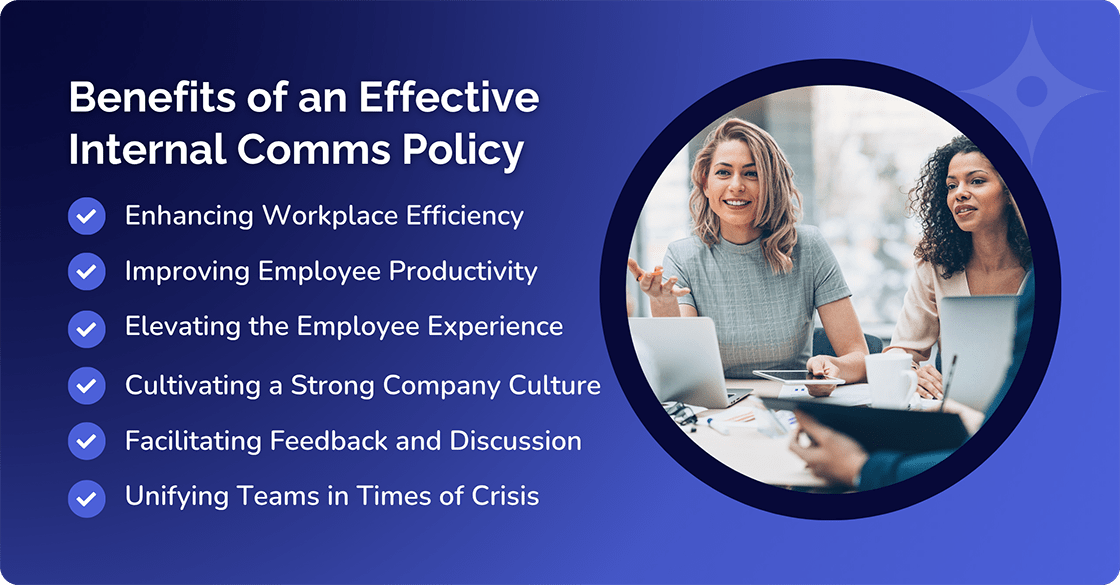
A comprehensive internal comms policy can have significant benefits for businesses of all sizes. These include improved morale, increased productivity, and better alignment with strategic goals.
Here’s a basic step-by-step guide that you can use to develop an effective communication policy.
Before writing an internal communication policy, make sure you understand the current situation. A good idea is to use focus groups or surveys to identify the need for improvement areas. You may also consider what types of communication are currently over or underused.
Based on your initial analysis, set clear objectives for your communication policy. These objectives may include improving transparency, increasing engagement, or enhancing communication effectiveness.
After setting objectives, utilize an internal communication policy template to design the best policy for your organization. This will involve creating a draft, sharing it with team members for feedback, making revisions, and finally implementing it. We have a free template that you can use! So, read on.
Once you and your team have implemented your new internal communication policy, periodically evaluate its effectiveness. Look for changes in employee engagement, satisfaction, and productivity. Also, gather feedback from employees to ascertain if the strategy is working or if it needs to be altered to be useful and/or improved.

Creating an effective internal communication policy requires more than guidelines. It demands tools that enable clarity, consistency, and control. Cerkl Broadcast is an internal communication platform built on AI, that supports every stage of policy development and implementation by providing the infrastructure and insights needed to bring your policy to life.
Ultimately, Cerkl Broadcast doesn’t just distribute messages, it helps operationalize your internal communication policy, making it measurable, adaptive, and actionable across your organization. Here’s how.
With Cerkl Broadcast, you can define and manage approved channels from a single omnichannel platform including email, your mobile app, intranet, or integrations with Teams and Slack, supporting your internal policy’s guidance on where and how communication should happen.
Cerkl’s intelligent personalization engine ensures employees only receive relevant content, reinforcing your policy’s objectives around minimizing overload and improving engagement. It guarantees that you can create a much more meaningful relationship with employees, ultimately increasing productivity and retention.
Built-in scheduling, approvals, and targeting features help communication teams maintain alignment with policy standards including tone, frequency, and message format, while reducing manual work for internal communicators and HR.
For example, internal communicators will find the ability to segment and automate employee distribution lists is a huge advantage.
Robust analytics show internal comms teams who are engaging with which messages, allowing them to evaluate how well the policy is being followed and where refinements are needed. This supports continuous improvement through data-backed decisions.
Easily segment employees by department, location, or behavior using HRIS integration and dynamic lists that are critical for delivering role-specific content and enforcing the scope defined in your communication policy. To achieve this, you will find that Cerkl’s Audience Manager is a brilliant tool.
If you need help creating a successful internal communication policy, the seasoned experts at Cerkl can help you. Our team has created an internal comms policy template that you can use to strengthen your workplace alignment. And it’s absolutely free. Amongst other things, it will help you plan your policy and then track its progress. There’s loads of advice and guidance, so don’t miss this opportunity.
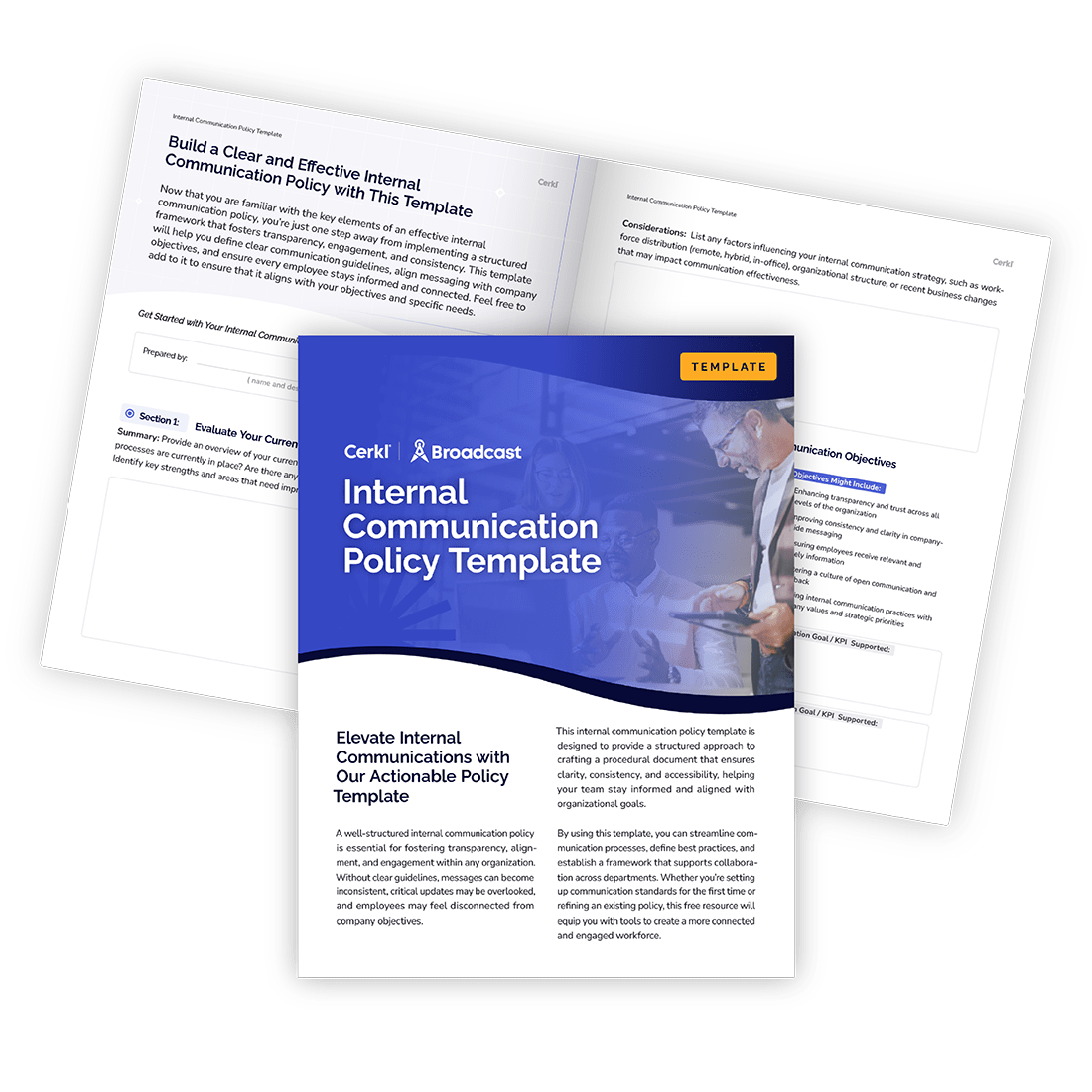
This template helps organizations establish clear, consistent internal communication practices that align teams, reduce confusion, and support a more connected workplace culture.
What is an internal communication policy? An internal communication policy is a set of guidelines and rules within an organization that define the principles, standards, and procedures governing the exchange of information among employees. The motivation behind a policy of this kind is to ensure clear, consistent, and effective communication practices.
What should an internal communication policy include? An internal communication policy should include guidelines on the use of communication channels, confidentiality protocols, professional conduct expectations, and rules for sharing information.
What is the aim of the communication policy? This policy aims to provide a structured framework that guides and governs internal communication within an organization. More precisely, it needs to ensure clarity, consistency, and effectiveness while aligning with the organization’s objectives and values.
What is a good communication policy? A good comms policy is clear, comprehensive, and aligned with the organization’s values and goals. It needs to provide guidelines for effective and transparent communication while addressing key areas. The most important of these are communication channels, confidentiality, and professional conduct.

This template helps organizations establish clear, consistent internal communication practices that align teams, reduce confusion, and support a more connected workplace culture.